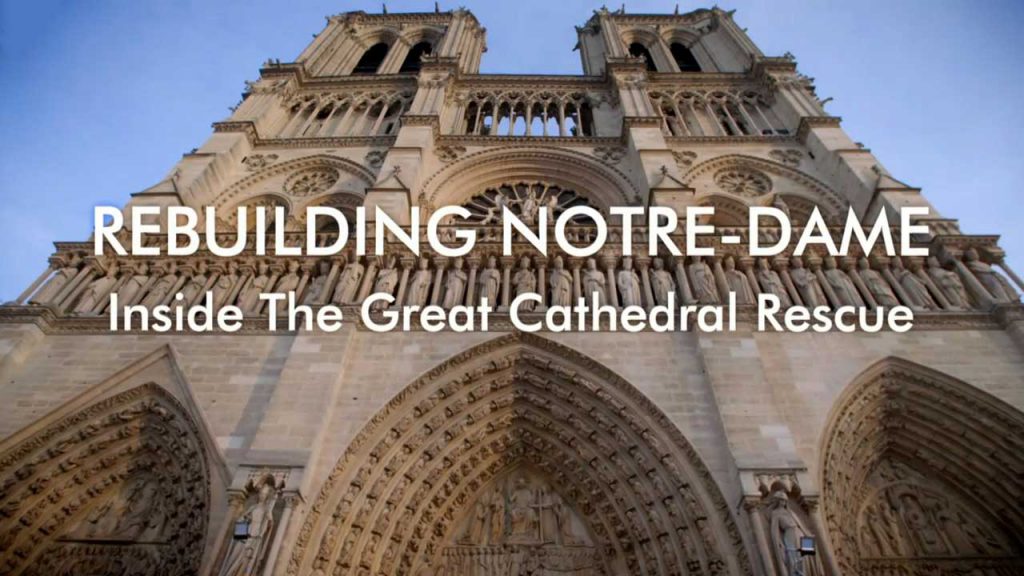Rebuilding Notre-Dame episode 1: Documentary that goes inside what remains of the world-famous Notre-Dame Cathedral in Paris. It is one year since the inferno devastated the vast timber and lead roof and the 850-year-old gothic masterpiece is still perilously close to collapse. Now, we follow the men and women fighting to secure the fire-ravaged structure. Lead dust from the vaporised roof contaminates the site, the stone ceiling is crumbling and a 500-tonne melted mass of scaffolding still hangs precariously over the cathedral, triggering alarms and evacuations.
Now that the cathedral walls are supported by giant timber frames, chief architect Philippe Villeneuve urgently needs a complete picture of the damage sustained during the fire. He initiates an unprecedented collaboration between architects and scientists. Their mission is to meticulously analyse the fallen timber, stone and fractured glass to develop a decontamination and restoration plan. This unique opportunity will give a new insight into the medieval materials, techniques and people who built Notre-Dame.
Inside the cathedral, glass scientist Claudine Loisel investigates the distribution of lead contamination on the stunning stained glass, comparing samples from around the building. In the lab she develops a decontamination plan using x-ray spectroscopy and identifies micro-cracks in the glass caused by ‘thermal shock’, sustained during the fire. At York Minster in northern England, conservationists are pioneering a glass preservation method that Claudine hopes will be adopted at Notre-Dame. They are installing ventilated protective glazing, which protects the medieval stained glass from harmful UV rays and the corrosive effects of moisture.
Rebuilding Notre-Dame episode 1
The stone vaulting has taken the brunt of the fire and will require new limestone with the same mechanical properties for the rebuild. Stone scientist Lise Leroux hunts for the origin of the vaulting stone, voyaging into the forgotten quarries beneath Paris, which are now filled with the bones of 18th-century Parisians. She finds a limestone micro-fossil signature in the lower level of the quarry that matches samples from the vaulting stones, confirming its origin. Lise discovers Notre-Dame is built from a variety of different limestone, chosen for the various structural properties needed for the cathedral.
The complex timber framework of the roof is completely destroyed. Amazingly, timber scientist Catherine Lavier still finds markings from the medieval carpenters on the burned beams and her tree-ring analysis of the timber tells the life story of the oak used. One team of carpenters still uses medieval tools and techniques to fell and carve beams for a chateau restoration, proving the skills and timber still exist in France to rebuild Notre-Dame’s lost roof framework. A 3D scan of the geometrically complex timbers of Notre-Dame offers the team a possibility to eventually rebuild the roof in the same way, down to the last millimetre.
The data from the scientists is combined into a groundbreaking ‘digital twin’ of Notre-Dame that will help them restore and rebuild the cathedral. This 3D dynamic map gives the team a complete view of every inch of the structure, before and after the fire, allowing them to click on an individual stone to see its chemical composition, its mechanical properties and its history within Notre-Dame over time.
Notre-Dame de Paris
Notre-Dame de Paris, referred to simply as Notre-Dame, is a medieval Catholic cathedral on the Île de la Cité (an island in the Seine River), in the 4th arrondissement of Paris. The cathedral, dedicated to the Virgin Mary, is considered one of the finest examples of French Gothic architecture. Several of its attributes set it apart from the earlier Romanesque style, particularly its pioneering use of the rib vault and flying buttress, its enormous and colourful rose windows, and the naturalism and abundance of its sculptural decoration. Notre Dame also stands out for its musical components, notably its three pipe organs (one of which is historic) and its immense church bells.
Construction of the cathedral began in 1163 under Bishop Maurice de Sully and was largely completed by 1260, though it was modified frequently in the centuries that followed. In the 1790s, during the French Revolution, Notre-Dame suffered extensive desecration; much of its religious imagery was damaged or destroyed. In the 19th century, the coronation of Napoleon I and the funerals of many of the French Republic’s presidents took place at the cathedral.
The 1831 publication of Victor Hugo’s novel Notre-Dame de Paris (known in English as The Hunchback of Notre-Dame) inspired popular interest in the cathedral, which led to a major restoration project between 1844 and 1864, supervised by Eugène Viollet-le-Duc. During World War II, after the Allies’ 1944 victory in Europe, the liberation of Paris was celebrated in Notre-Dame with the singing of the Magnificat. Beginning in 1963, the cathedral’s façade was cleaned of centuries of soot and grime. Another cleaning and restoration project was carried out between 1991 and 2000.





Pingback: Rebuilding Notre-Dame episode 1 – HDclump | Notre-Dame de Paris